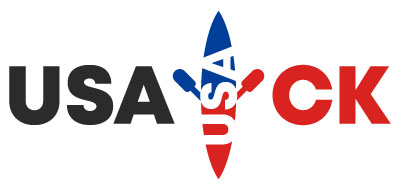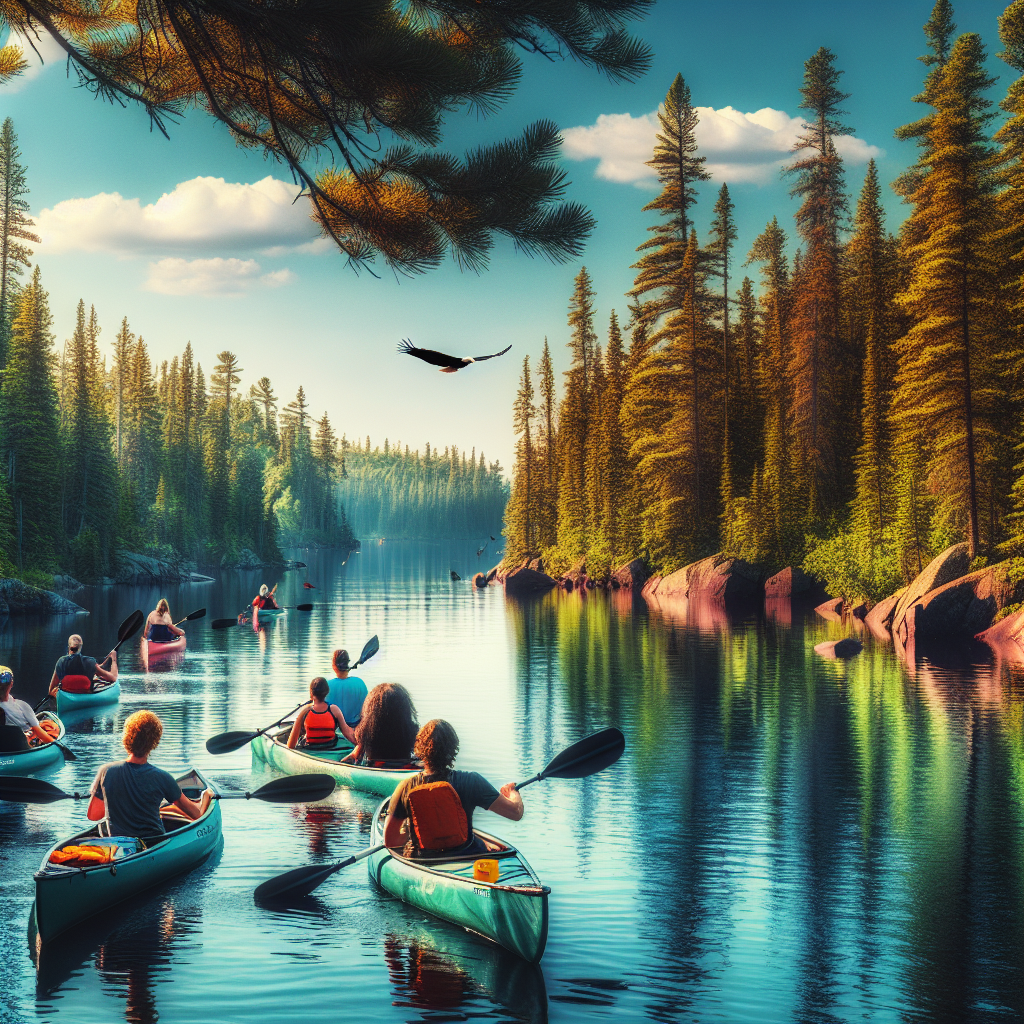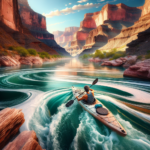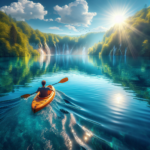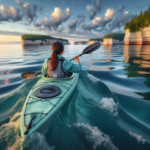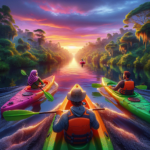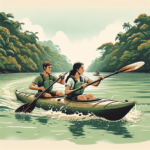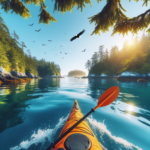Kayaking in Boundary Waters Canoe Area, Minnesota, USA
Introduction to Kayaking
Kayaking is a popular outdoor activity that offers a unique blend of adventure, exercise, and a close connection with nature. Whether you’re paddling through serene lakes, navigating swift rivers, or exploring coastal waters, kayaking provides an exhilarating experience that appeals to both beginners and seasoned adventurers. The sport has grown in popularity over the years, thanks to its accessibility and the minimal equipment required to get started.
In this article, we will spotlight the Boundary Waters Canoe Area (BWCA) in Minnesota, USA, a premier destination for kayaking enthusiasts. We’ll explore the unique features that make this location a must-visit for anyone passionate about kayaking. From its stunning geography and diverse wildlife to its rich history and cultural significance, the BWCA offers an unparalleled kayaking experience.
Kayaking in the Boundary Waters Canoe Area is not just about paddling; it’s about immersing yourself in a pristine natural environment. The area is renowned for its interconnected waterways, lush forests, and abundant wildlife, making it a haven for outdoor enthusiasts. Whether you’re looking for a challenging adventure or a peaceful retreat, the BWCA has something to offer.
What sets the BWCA apart from other kayaking destinations is its unique combination of natural beauty, historical significance, and well-preserved wilderness. The area is a designated wilderness area, meaning it is protected from development and motorized vehicles, ensuring a tranquil and unspoiled environment for kayakers. Let’s dive deeper into what makes kayaking in the Boundary Waters Canoe Area a truly special experience.
Overview of Kayaking in Boundary Waters Canoe Area, Minnesota, USA
The Boundary Waters Canoe Area is located in northeastern Minnesota, bordering Canada. It spans over a million acres and includes more than 1,100 lakes and hundreds of miles of rivers and streams. The geography of the area is characterized by rugged terrain, dense forests, and crystal-clear waters, making it an ideal setting for kayaking.
The climate in the BWCA varies throughout the year, with warm summers and cold winters. The best time to visit for kayaking is from late spring to early fall when the weather is mild, and the waters are accessible. During these months, the area comes alive with vibrant foliage, blooming wildflowers, and an abundance of wildlife, providing a picturesque backdrop for your kayaking adventure.
Historically, the BWCA has been a significant area for indigenous peoples and early explorers. The waterways served as vital transportation routes for Native American tribes and fur traders. Today, the area continues to hold cultural and historical importance, with many visitors coming to experience its rich heritage and natural beauty.
Accessing the BWCA is relatively straightforward. The main entry points are located in Ely, Grand Marais, and Tofte, Minnesota. From these towns, visitors can obtain permits, rent equipment, and receive guidance on the best routes and spots for kayaking. It’s essential to plan ahead and secure permits, as the BWCA is a protected area with limited access to preserve its pristine condition.
Kayaking Conditions in Boundary Waters Canoe Area, Minnesota, USA
The Boundary Waters Canoe Area offers a variety of water conditions suitable for different levels of kayaking experience. The area is primarily composed of interconnected lakes and rivers, providing a diverse range of paddling environments. Whether you prefer calm, flat waters or more challenging currents, the BWCA has something to offer.
The weather conditions in the BWCA can vary significantly throughout the year. Summers are generally warm, with temperatures ranging from the mid-60s to the mid-80s Fahrenheit. This is the most popular time for kayaking, as the waters are warm and the days are long. Fall brings cooler temperatures and stunning foliage, making it another excellent time for kayaking. Winters are cold and snowy, making kayaking less feasible but offering opportunities for other winter sports.
Water currents in the BWCA are generally mild, making it suitable for kayakers of all skill levels. However, it’s essential to be aware of the weather conditions and potential changes in water levels, especially after heavy rains. The interconnected nature of the waterways means that you can easily plan routes that match your skill level and desired level of challenge.
Environmental factors such as wind and weather patterns can also impact your kayaking experience. It’s crucial to check weather forecasts and be prepared for sudden changes in conditions. The BWCA is known for its remote and rugged nature, so being well-prepared and informed is key to a safe and enjoyable kayaking trip.
Top Spots for Kayaking in Boundary Waters Canoe Area, Minnesota, USA
The Boundary Waters Canoe Area is home to numerous top spots for kayaking, each offering unique features and experiences. One of the most popular areas is the Basswood Lake, known for its stunning scenery and abundant wildlife. The lake is relatively large, providing plenty of space for exploration and opportunities to spot eagles, loons, and even moose.
Another must-visit spot is the Knife Lake, which offers a mix of calm waters and more challenging sections. The lake is surrounded by rugged cliffs and dense forests, providing a picturesque setting for your kayaking adventure. The area is also rich in history, with several historical sites related to early explorers and Native American tribes.
For those looking for a more secluded experience, the Lac La Croix is an excellent choice. This remote lake is less frequented by visitors, offering a peaceful and tranquil environment. The lake is known for its clear waters and excellent fishing opportunities, making it a great spot for a multi-day kayaking trip.
The best time of day for kayaking in the BWCA is typically early morning or late afternoon when the waters are calm, and the wildlife is most active. The best time of year depends on your preferences, with summer offering warm weather and vibrant scenery, while fall provides cooler temperatures and stunning foliage. Regardless of when you visit, the BWCA offers an unforgettable kayaking experience.
Safety and Regulations
Safety is paramount when kayaking in the Boundary Waters Canoe Area. The area is remote and rugged, so it’s essential to be well-prepared and informed. Local regulations require all visitors to obtain a permit before entering the BWCA. These permits help manage the number of visitors and preserve the area’s pristine condition.
When it comes to safety gear, always wear a life jacket and carry a whistle or other signaling device. It’s also advisable to bring a first aid kit, a map, and a compass or GPS device. Weather conditions can change rapidly, so be prepared for sudden changes and always check the forecast before heading out.
In case of an emergency, it’s crucial to know how to handle the situation. Familiarize yourself with basic first aid and rescue techniques. If you’re kayaking in a group, establish a plan for staying together and communicating in case someone gets separated. Cell phone reception is limited in the BWCA, so consider bringing a satellite phone or emergency beacon.
Respecting local regulations and guidelines is essential for preserving the BWCA’s natural beauty and ensuring a safe experience for all visitors. Follow Leave No Trace principles, such as packing out all trash and minimizing your impact on the environment. By doing so, you help protect this unique wilderness area for future generations to enjoy.
Amenities and Accommodations
The Boundary Waters Canoe Area offers a range of amenities to make your kayaking trip more enjoyable. Several rental facilities in nearby towns like Ely and Grand Marais provide kayaks, paddles, life jackets, and other essential gear. These facilities often offer guided tours and expert advice on the best routes and spots for kayaking.
When it comes to accommodations, the BWCA has something for everyone. For those who prefer a more rustic experience, numerous campsites are scattered throughout the area. These sites are typically equipped with fire grates, latrines, and tent pads. Camping in the BWCA allows you to fully immerse yourself in the wilderness and enjoy the tranquility of the area.
If you prefer more comfortable accommodations, several lodges and cabins are available in the surrounding towns. These lodges often offer additional amenities such as hot showers, dining options, and guided tours. Staying in a lodge provides a convenient base for exploring the BWCA while enjoying some modern comforts.
In addition to kayaking, the BWCA offers a variety of other recreational activities. Fishing is a popular pastime, with the area’s lakes and rivers teeming with fish. Hiking trails provide opportunities to explore the rugged terrain and enjoy stunning views. Wildlife watching is another highlight, with the chance to see eagles, moose, and other native species.
Environmental Considerations
Preserving the natural habitats and wildlife of the Boundary Waters Canoe Area is of utmost importance. The area is a designated wilderness area, meaning it is protected from development and motorized vehicles. Visitors are encouraged to follow eco-friendly practices to minimize their impact on the environment.
One of the key principles to follow is Leave No Trace. This includes packing out all trash, minimizing campfire impact, and respecting wildlife. Avoid disturbing plants and animals, and stay on designated trails and campsites to prevent erosion and habitat destruction. By following these guidelines, you help protect the BWCA’s pristine condition.
Several conservation efforts and local projects are in place to preserve the BWCA’s natural beauty. Organizations like the Friends of the Boundary Waters Wilderness work to protect the area through advocacy, education, and volunteer efforts. Visitors can support these efforts by donating, volunteering, or participating in conservation programs.
Eco-friendly kayaking practices include using biodegradable soap, avoiding the use of single-use plastics, and being mindful of your impact on the water and surrounding environment. By adopting these practices, you contribute to the preservation of the BWCA and ensure that future generations can enjoy its beauty.
Highlights
When comparing the Boundary Waters Canoe Area to other popular kayaking locations, several unique features stand out. The BWCA’s vast network of interconnected lakes and rivers provides endless opportunities for exploration. The area’s remote and rugged nature offers a true wilderness experience that is hard to find elsewhere.
The biodiversity of the BWCA is another highlight. The area is home to a wide variety of plant and animal species, including several that are rare or endangered. The chance to see wildlife such as moose, eagles, and loons in their natural habitat adds to the allure of kayaking in the BWCA.
Geographically, the BWCA is characterized by its rugged terrain, dense forests, and crystal-clear waters. The area’s unique combination of lakes, rivers, and streams creates a diverse range of paddling environments. Whether you prefer calm, flat waters or more challenging currents, the BWCA has something to offer.
Historically, the BWCA holds significant cultural importance. The waterways served as vital transportation routes for Native American tribes and early explorers. Today, visitors can explore historical sites and learn about the area’s rich heritage while enjoying its natural beauty. This combination of history and nature makes the BWCA a truly unique kayaking destination.
FAQ Section
- What is the best season to go kayaking in the Boundary Waters Canoe Area? The best season for kayaking in the BWCA is from late spring to early fall when the weather is mild, and the waters are accessible.
- Are there beginner-friendly spots for kayaking in the BWCA? Yes, there are several beginner-friendly spots with calm waters and easy access, such as Basswood Lake and Knife Lake.
- What should I bring for a kayaking trip in the BWCA? Essential items include a life jacket, paddle, map, compass or GPS, first aid kit, and appropriate clothing for the weather.
- Are kayak rentals available in the BWCA? Yes, several rental facilities in nearby towns like Ely and Grand Marais offer kayaks and other essential gear.
- How can I participate in local conservation efforts? You can support organizations like Friends of the Boundary Waters Wilderness through donations, volunteering, or participating in conservation programs.
- Are guided kayaking tours available? Yes, many rental facilities and lodges offer guided tours that provide expert advice and ensure a safe and enjoyable experience.
- What safety measures should I take while kayaking in the BWCA? Always wear a life jacket, carry a whistle or signaling device, check weather forecasts, and be prepared for sudden changes in conditions.
Final Thoughts
Kayaking in the Boundary Waters Canoe Area, Minnesota, USA, is a premier destination for kayaking enthusiasts. The area’s stunning geography, diverse wildlife, and rich history make it a must-visit for anyone passionate about outdoor adventure. Whether you’re a seasoned kayaker or a beginner, the BWCA offers an unforgettable experience.
Respecting local guidelines and conservation efforts is essential for preserving the BWCA’s natural beauty. By following Leave No Trace principles and supporting local conservation organizations, you help protect this unique wilderness area for future generations to enjoy.
In conclusion, the Boundary Waters Canoe Area offers a unique combination of natural beauty, historical significance, and well-preserved wilderness. It’s a place where you can immerse yourself in nature, challenge yourself with new adventures, and create lasting memories. We invite you to explore the beauty and thrill of kayaking in the Boundary Waters Canoe Area, Minnesota, USA.
